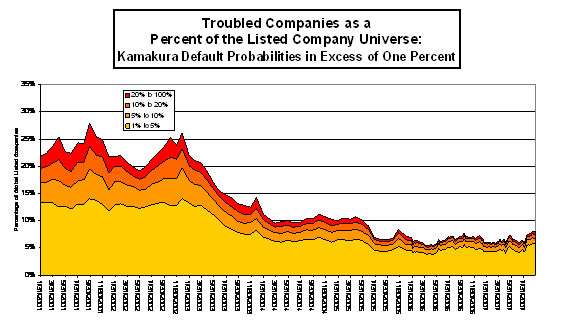Global Credit Quality Continues to Decline
Location: Honolulu
Author:
Kamakura Staff
Date: Monday, October 1, 2007
Kamakura Corporation reported last week that eight percent of global public companies were classified as troubled by the end of September, the fourth consecutive monthly decline in credit quality. The Kamakura troubled company index was 7.7 percent in August and 6.3 percent as recently as June.
The number of troubled companies has not reached the eight percent level on a sustained basis since the second quarter of 2005. September 2007 global credit quality remained better than 78.6 percent of the monthly periods since January 1990, down sharply from a 96.7 percent rank in June. The average value of the index has been 13.5 percent over the last 17 years.
Kamakura defines a troubled company as a company whose default probability is in excess of one percent. The index now covers more than 20,000 public companies in 29 countries using the fourth generation version of Kamakura's advanced credit models.
"The credit crisis of this summer continues to reach more sectors of the economy," said Warren Sherman, Kamakura President and Chief Operating Officer. "The bankruptcy of The Bombay Company, Inc. and the seizure of NetBank by regulators are symbolic of the widening credit problems. The percentage of the global corporate universe with default probabilities between 1% and 5% increased from 5.5% of the universe at the end of August to 5.8% of the universe at the end of September. The percentage of companies with default probabilities between 5% and 10% was down 0.1% to 1.0% of the universe in September. The percentage of the universe with default probabilities between 10 and 20% was up 0.2% to 0.8% of the universe. The percentage of companies with default probabilities over 20% increased by 0.1% to 0.5% of the total universe in September."
Beginning in January 2006, Kamakura has moved to a global index covering 29 countries using the annualized one month default probability produced by the best performing credit model of the Kamakura Risk Information Services default and correlation service. The model used is the fourth generation Jarrow-Chava reduced form default probability, a formula that bases default predictions on a sophisticated combination of financial ratios, stock price history, and macro-economic factors. The countries currently covered by the index include Australia, Austria, Belgium, Brazil, Canada, Denmark, Finland, France, Germany, Hong Kong, India, Ireland, Israel, Italy, Japan, Luxemburg, Malaysia, the Netherlands, New Zealand, Norway, Singapore, South Africa, South Korea, Spain, Sweden, Switzerland, Taiwan, United Kingdom, and the United States.
